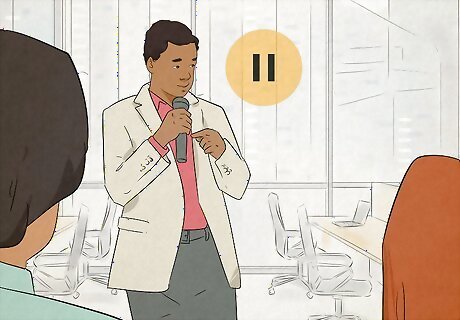
views
Get rid of distractions before speaking.

Talking is easier when no TV or phone is competing for attention. Getting your point across might be difficult if you're talking to an easily distracted friend or a colleague with their email pulled up. Find time to talk when the other person isn't preoccupied with something else. Or, if they are, politely ask if it's better to talk another time. That should get their attention and prompt them to focus. Just as you need to focus on the other person while they talk, it's also vital for them to give you their full attention—and it's okay to politely ask for that focus.
Be direct and concise.

Get to the point and stay on topic to hold your listeners' attention. Summarise what you want to say before saying it and focus on the issue at hand, cutting out any unrelated chatter. Make your point within the first 30 seconds of the conversation to ensure your audience is listening. It’s most effective to explain less rather than more when you have something important to say! Ask concise questions, too. "Will you please pass me that paper?" is far more direct and engaging than, "Excuse me? I was just wondering—if you have a minute—would you mind passing me that paper, please?" A pleasantry like "please," “thank you,” or "Hello, everyone!" is still important to include in any conversation, so you can appear confident without being too blunt or impolite. If you try to give a great amount of detail or go on a long tangent, you run the risk of people losing interest. The more you say, the less likely people are to remember all of it. You can always redirect the conversation if the other person gets off-topic. If a friend goes on a lengthy tangent, you could wait until they finish talking and say, "So, I've been thinking about our conversation earlier…"
Use positive language.

Positivity is more appealing to listeners than negativity. Avoid filling up a conversation with complaints, excuses, and pessimistic comments. Phrase your words constructively, focusing on ideas to address the problem rather than the problem itself when talking about a serious subject. Express your feelings without throwing around accusations or insults. Understandably, not every conversation can be positive. One way to keep your words from getting too negative is to use "I" statements, describing your feelings without accusing the other person of anything. If you feel like someone isn’t listening, address this with an I-statement. Say, "I feel sad when it seems like my ideas aren’t being taken seriously," instead of, "You don’t care what I have to say!"
Stick to the facts.

Exaggerating a situation makes you seem less reliable to listeners. Frequent use of words like "never" and "always" indicates that you might have a tendency to exaggerate. Instead, focus on the facts and be as honest as you can (while still being polite). People are much more likely to listen to fact-based information than wild exaggerations. For example, "You're always late! It's so annoying" is an exaggeration. If you want to address the issue, try, "You've been late twice in a row now. Would it help if we added a little extra wiggle room in our plans next time?"
Speak with a clear, natural tone of voice.

Natural-sounding speech helps listeners stay attentive. Talk at a moderate conversational volume without being too loud or too quiet. Take the time to enunciate your words, pronouncing each one fully before moving to the next. Speak evenly at a full, smooth pitch so that you sound confident. When you’re approachable, calm, and self-assured, people are more likely to listen. Try not to mumble, even if you're shy. Pay attention to the other person's body language—if they're leaning forwards and looking puzzled, they might be struggling to hear you. That's your cue to raise your voice a little!
Take a pause between thoughts.

Pauses give you time to breathe, refocus, and have a meaningful talk. Give a brief pause each time you share a complete thought in conversation. As you do, take a couple of deep breaths and center yourself. Consider your next words and focus on what you're trying to communicate so that you have an idea of what you'll say before you start speaking again. Pauses can help you stay calm and on-topic throughout the conversation. If you're having an intense conversation with a friend or loved one, they're more likely to listen to a collected and thoughtful person. It can also help you sound more authoritative during speeches and presentations since you'll have a moment to refocus your thoughts and plan ahead.
Use authoritative body language.

Body language show people that you have something important to say. Stand tall and straight, keep your eyes up and looking forward, and relax your face while talking. Body language is an honest reflection of how you feel, so make sure your body’s physical cues match the tone and intent of your words. If you speak earnestly and use open body language, people will believe you're genuine. If your body language doesn't match your words, on the other hand, people might doubt what you're saying. For example, if you say "I agree" while crossing your arms and looking away, it suggests you disagree. To match your words and body language, you could say "I agree" while nodding and standing straight with your arms at your sides. Your open body language will convey honesty!
Make eye contact.

Steady eye contact encourages engagement and interaction. Maintain eye contact with the person you are talking to in a non-aggressive way. Hold for roughly 5 seconds and then look away slowly before returning to make eye contact. Make eye contact 50% of the time when you're talking and 70% of the time when you're listening. When you make eye contact, you'll seem more trustworthy and earnest. Try to establish eye contact before you start speaking to someone to make a strong first impression.
Analyze your audience’s body language.

Speed up the conversation if you notice the other person losing focus. Body language can tell you how someone else is feeling. If the other person appears to be distracted or disengaged, get straight to the point as fast as you can. Be persistent, repeat yourself if necessary, and ask a question to engage the other person and recapture their attention. Look out for the following nonverbal signals: Folded arms suggest that the person feels closed off or defensive. Lack of eye contact indicates that someone isn't listening or might even be embarrassed. However, remember that breaking eye contact for short periods is normal! Turning or leaning away might mean that the other person is losing interest and looking to get away. If the other person seems engaged, making plenty of eye contact, fully facing you, and leaning towards you, then you can continue the conversation naturally!
Find common ground with the audience.

Figure out what interests your audience so you can hold their attention. If you want people to listen to your ideas, consider who your audience is and what they like or respond to. Find a way to connect your ideas with their concerns and experiences. If you frame your message inclusively, your audience may be more receptive to what you have to say. For example, if you are explaining a problem, relate it to something that the person you're talking to has experienced. You might find it easier to share your thoughts and communicate with like-minded people with similar experiences and outlooks to yours. When giving a work presentation, knowing your audience is important. Learn about the people you'll be presenting to and use that knowledge to form a connection with them during your speech.
Listen actively to other people.

Active listening shows you're engaged and gets others to do the same. Whether a serious conversation with a family member or a business discussion with some colleagues, make an effort to listen to their concerns. Maintain eye contact with the other person, give them your undivided attention, and empathize with their perspective. To get people to listen, you have to show them you're a good listener too! Avoid interrupting the other person. Instead, show them you're listening with small gestures, like a nod or verbal "uh-huh." Though you may disagree, remember to be non-judgmental. You want them to respect your thoughts and ideas, so take the initiative and show them the same respect.



















Comments
0 comment